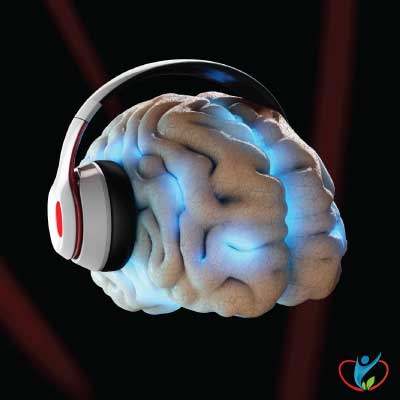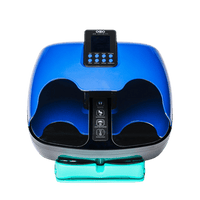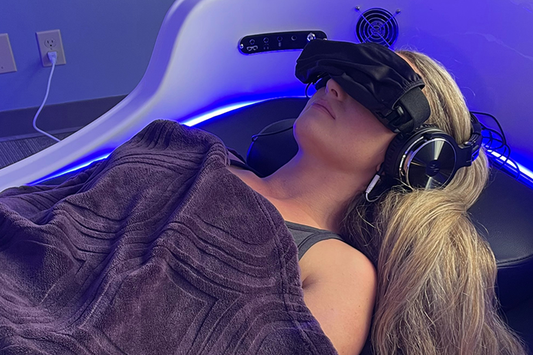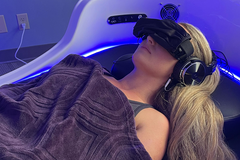Music lifts the spirits and stimulates the mind, but the tones that form music are being investigated for their ability to treat disorders like chronic pain and anxiety. It’s not the direct effects of tones on these issues that are being investigated; rather, these tones affect the brain in such a way as to lessen the impact of such disorders.

Brainwave Entrainment
Brainwave entrainment is a form of neurofeedback. Its purpose is to help people learn to change their brainwaves when presented with a specific cue, which in this discussion, involves tones. Brainwaves are synchronized rhythmic patterns of electrical activity associated with particular states of activity and levels of consciousness. There are 5 recognized patterns, from lowest and slowest to most active:
- Delta brainwaves. Delta waves are the slowest of all brainwaves. They’re predominately associated with deep, dreamless sleep. They should not be seen when a person is conscious.
- Theta brainwaves. Theta waves are found when we’re between a waking state and falling asleep, but they also appear when we’re daydreaming. Theta waves are associated with feelings of calmness and serenity.
- Alpha waves. Alpha waves are found when we’re observing the world around us. We’re conscious but not using our minds to focus, concentrate, or think about anything. Alpha waves signal that the brain is alert but idle.
- Beta. Beta waves occur when we’re highly alert, conscious, and focused. It’s our default waking state and consumes more of our emotional and psychological reserves than other brainwave patterns.
- Gamma. Gamma waves occur when the brain is processing information from different parts of the brain simultaneously. They’re the fastest of all brain waves.
Entrainment teaches a person how to shift their brainwave patterns to meet their needs at any given moment. For example, a person suffering from excessive anxiety would benefit from changing to an alpha wave pattern.
Brainwave entrainment has been moderately studied and found to be effective as a therapeutic tool when working with issues like migraine, chronic stress and anxiety, chronic pain, and some behavioral problems.
Using sound tones as an entrainment tool is particularly effective because of the brain’s tendency to synchronize brainwaves to match repetitive external stimuli. This frequency following response allows a person to change their brainwave pattern by changing the pattern of tones they’re listening to.
Tones for Healing and Improved Cognition
People who use music tones for improved cognition have three choices for using sound as an entrainment tool: isochronic tones, monaural beats, and binaural beats. These are all commonly used in the process of brainwave entrainment, which teaches a person to shift their brain’s activity to synchronize with external stimuli, such as these tones.
Isochronic tones. An isochronic tone is a distinct, single tone composed of one wavelength that’s rapidly pulsed or switched on and off. Isochronic tones have been used to help people meditate and relax, as well as reduce anxiety. An isochronic tone’s effects are produced because of the brain’s tendency to synchronize with precise external stimuli. Isochronic tones do not require headphones.
Binaural Beats. Binaural beats are also used to help people learn to alter their brainwaves. They require headphones to make sure each ear is presented with only one tone. To create a binaural beat, continuous tones of slightly different frequencies are sent to separate ears. For example, one tone of 400 hertz is sent to one ear, while a tone of 420 hertz is sent to the other. In this case, the listener will perceive a tone of 20 hertz. In other words, the perceived sound heard by the listener will be equal to the difference in frequency between the two simple tones. Note that there isn’t a real 20-hertz tone being played in the above example. A binaural beat is a type of auditory hallucination.
Monaural Beats. Monaural beats are formed from combining two continuous tones that are close together in frequency, then sending each combined tone to the ears. The effects for monaural beats are essentially the same as with binaural beats; only the method of making them is different. Monaural beats can be used with or without headphones, but they do not require headphones.
Which Tones to Use?
Binaural beats are used by more people than any other music/tone for brainwave entrainment, however, research studies have indicated that there may not be significant differences between monaural beats and binaural beats when it comes to improving cognition. Both seem to be effective to the same degree. Here are some examples of where they are used.
- Binaural beats have been the subject of several small studies, which indicated that they may be useful for increasing attention span and improving cognition.
- Isochronic, monaural and binaural tones are often used by students to increase their concentration and ability to focus.
- Many meditative practices, like yoga and massage therapy, benefit from binaural beats by helping practitioners to relax while staying alert.
- Binaural beats are also played in theta chambers, which are highly specialized total-immersion pods that help people get into the theta wave brainwave pattern discussed previously.
The Takeaway
Isochronic, monaural, and binaural beats are types of music tones effective in helping people learn to shift their brainwave patterns to more helpful states. Tones are effective in promoting a relaxed but alert state of mind useful in yoga, meditation, and therapeutic massage.
Works Cited
- Batra, R., Kuwada, S., & Maher, V. L. (2003, March 18). The frequency-following response to continuous tones in humans. Hearing Research. https://www.sciencedirect.com/science/article/abs/pii/0378595586900377.
- Binaural beats Vs. MONAURAL Beats: What's the difference & which is better? Binaural Beats. (2021, March 11). https://www.binauralbeatsfreak.com/binaural-beats/binaural-beats-vs-monaural-beats.
- Chaieb, L., Wilpert, E. C., Hoppe, C., Axmacher, N., & Fell, J. (1AD, January 1). The impact of monaural beat stimulation on anxiety and cognition. Frontiers. https://www.frontiersin.org/articles/10.3389/fnhum.2017.00251/full.
- Colzato, L., Barone, H., Sellaro, R., & Hommel, B. (2015, November 25). More attentional focusing through binaural beats: Evidence from the global–local task. Retrieved August 14, 2021, from https://link.springer.com/article/10.1007%2Fs00426-015-0727-0
- Curtis, D. (2007, November). BINAURAL BEATS, BRAIN WAVE ENTRAINMENT AND THE HEMI-SYNC PROCESS. https://www.researchgate.net/profile/Darren-Curtis/publication/267198870_
- DeAngelis, T. (2020, November 1). Music's power over our brains. Monitor on Psychology. https://www.apa.org/monitor/2020/11/news-music-power.
- Engelbregt, H., Meijburg, N., Schulten, M., Pogarell, O., & Deijen, J. B. (2019). The effects of binaural and monoaural beat stimulation on cognitive functioning in subjects with different levels of emotionality. Advances in Cognitive Psychology, 15(3), 199-207. https://doi.org/10.5709/acp-0268-8
- Garcia-Argibay, M., Santed, M. A., & Reales, J. M. (2019). Efficacy of binaural auditory beats in cognition, anxiety, and pain perception: a meta-analysis. Psychological research, 83(2), 357–372. https://doi.org/10.1007/s00426-018-1066-8
- Hink, R., & Kodero, K. (2009, July 7). Binaural interaction of a beating frequency-following response. Audiology. https://www.tandfonline.com/doi/abs/10.3109/00206098009072647.
- Huang, T. L., & Charyton, C. (1970, January 1). A comprehensive review of the psychological effects of brainwave entrainment. Database of Abstracts of Reviews of Effects (DARE): Quality-assessed Reviews [Internet]. https://www.ncbi.nlm.nih.gov/books/NBK75019/.
- Kraus, J. (n.d.). The effects of binaural beats on working memory capacity. Retrieved August 15, 2021, from http://www.studiapsychologica.com/uploads/KRAUS_SP_2_vol.57_2015_pp.135-145.pdf Retrieved August 15th 2021.
- Lane, J., Kasian, S., Owens, J., & Marsh, G. (1998, January 30). Binaural auditory beats affect vigilance performance and mood. Physiology & Behavior. https://www.sciencedirect.com/science/article/abs/pii/S0031938497004368.
- Marzbani, H., Marateb, H. R., & Mansourian, M. (2016). Neurofeedback: A Comprehensive Review on System Design, Methodology and Clinical Applications. Basic and clinical neuroscience, 7(2), 143–158. https://doi.org/10.15412/J.BCN.03070208
- Padmanabhan, R., Hildreth, A., & Laws, D. (2005, July 07). A prospective, randomised, controlled study Examining binaural beat audio And pre‐operative anxiety in patients undergoing general anaesthesia for day case SURGERY*. Retrieved August 15, 2021, from https://associationofanaesthetists-publications.onlinelibrary.wiley.com/doi/full/10.1111/j.1365-2044.2005.04287.x
- Rice, A. (2021, March 30). Playing this during yoga can help you be even more relaxed. Yoga Journal. https://www.yogajournal.com/practice-section/play-binaural-beats-during-yoga-to-help-you-relax/.
- Scientific American. (1997, December 22). What is the function of the various brainwaves? Scientific American. https://www.scientificamerican.com/article/what-is-the-function-of-t-1997-12-22/. Retrieved August 10th, 2021.
- Seladi-Schulman, J. (2020, February 28). Isochronic tones: Benefits, research, beats, and more. Healthline. https://www.healthline.com/health/isochronic-tones.












